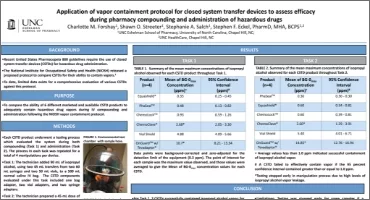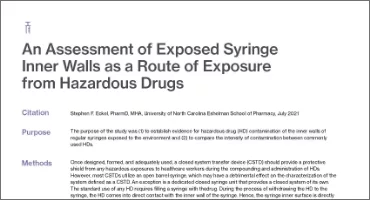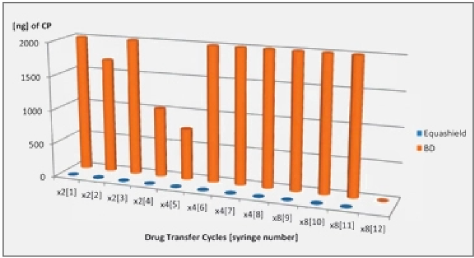Purpose:
The primary objective o f this study was to determine the effectiveness of three hazardous drug surrogates suggested by NIOSH with 5 vented CSTDs and thereby help to exclude ineffective surrogates from the NIOSH surrogates list, as ineffective surrogates m ay lead to a false sense o f security from the use o f CSTDs, thereby putting the w ell-being o f healthcare workers at risk
Methods:
The continuously updated NIOSH list of hazardous drugs contains a large variety of molecules and compounds. NIOSH states that “… air-cleaning technologies can have varying efficiencies based upon the chemical and physical make-up of the contaminant.” The current study was intended to assess the varying efficiencies of air-cleaning CSTDS and the appropriateness of 3 out of 9 HD surrogates (tetramethylurea, tetraethylurea, and propylene glycol) suggested by NIOSH for use in testing o f aircleaning CSTDs. This study was designed to evaluate straightforward the vapor containment efficacy o f the air-cleaning technology (air filter test) in 5 commercially available air-cleaning CSTDs during simulated hazardous drug reconstitution using 3 of the 9 NIOSH-proposed surrogates and the Gasmet DX4040 FU R analyzer which is also utilized by NIOSH for the development o f its CSTD performance protocols. The DX4040 analyzer is designed to detect over 300 various gases at low concentrations, including 5 of the 9 NIOSH surrogates. The analyzer’s air sampling funnel was placed externally next to the vent opening o f an air-cleaning CSTD vial adapter during the injection o f 60ml of diluent (water) into a vial containing 3ml of undiluted surrogate.
The analyzer was run on continuous mode to collect the vented air from the CSTDs and any escaped surrogate vapor concentrations were detected, quantified and displayed in real-time. The surrogate concentration selected for this study was intended to correspond to the real-world condition of a 3-gram dose of ifosfamide free of excipients (eg, 3mL surrogate) and the required injection of 60ml of diluent (water) during the reconstitution process. In this study, 10 replications of testing for each of the CSTDs was conducted with each surrogate, yielding a total of 150 measurements. 72-hours after testing, a compatibility assessment was performed to exclude CSTD incompatibility with the surrogates. The compatibility study assessed whether the functionality and integrity of the
tested CSTDs are affected.
Conclusions:
The tested air-cleaning CSTDs failed to contain vapor, and significant concentrations were released into the environment, which were detected and quantified; Tetramethylurea concentrations were the highest, followed by Tetraethylurea. Propylene Glycol was proven to be an inappropriate and
ineffective surrogate since minimal detectable concentrations of Propylene Glycol were released into the environment from CSTDs that utilize carbon filters with additional hydrophobic filters. The study provided evidence and data to confirm that air-cleaning technologies can have varying efficiencies
based upon the chemical and physical make-up of the contaminant. The tested surrogates were found compatible under the tested conditions with the tested CSTDs.



